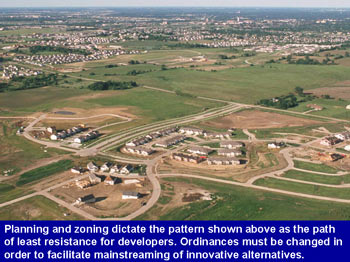Land-Use Planning and Zoning
EPA recognizes that local-level decisions make all the difference in strategizing and implementing a coherent vision of growth. The key elements of such strategies are master plans and zoning ordinances. Master plans form the basis for making public and private decisions on land use regulation and development, future investment and the allocation of critical resources. Master plans also deal with growth boundaries and define where future developments are planned.
Zoning ordinances define the permitted uses of land and buildings, the size of lots and yards around homes and buildings, the size of parking lots, the width of roads and other characteristics of development. Existing zoning determines the form of our communities: most of what we see is simply built to conform with existing local laws. These highly proscriptive guidelines define for developers a path of least resistance for conventional, low-density, automobile-dependent development. Towns like many of the historic cities and towns that people cherish and love to visit can no longer be replicated under current zoning requirements. Multiple variances would be required, costing developers time and money. As long as innovative practices require exceptional treatment from local governments, they will not become mainstream.
Community growth and management strategies should allow for the following:
- Periodic revision of master plans to reflect evolving community visions and goals
- Mainstreaming of innovative landscape design modifications, such as low-impact development techniques, and traditional patterns of development (i.e., New Urbanism) that help to achieve watershed protection goals.
- Updating of zoning ordinances that use outdated justifications or rely on historical conventions, such as parking lot requirements that have excess capacity in areas that offer transit alternatives.
![[logo] US EPA](https://www.epa.gov/epafiles/images/logo_epaseal.gif)
